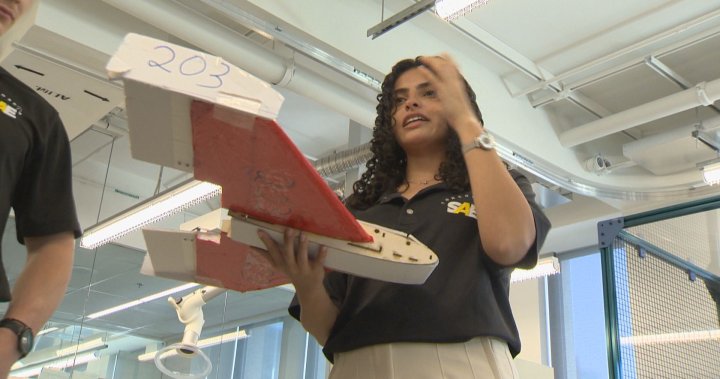Emergency services experts and engineers are working to solve the challenge of efficiently resupplying crews fighting forest fires, as the number of fires continues to increase globally. The Society of Automotive Engineers (SAE) is addressing this issue by tasking university students from around the world with designing aircraft solutions for fire suppression. Concordia University in Montreal participated in the 2023-24 SAE Aero Design competition, aiming to build two planes to safely bring supplies to firefighting crews. The team captain, aerospace engineering student Joey Vezina, explained that the larger aircraft with a camera onboard would detect fires, while the smaller autonomous delivery aircraft would deliver supplies to the ground crew.
In a real-life scenario, the piloted plane would drop a fixed-winged drone with cargo into the fire area multiple times. The Concordia University team had to demonstrate how their model plane and model drone would function in this setup. The advanced competition, featuring 17 teams, resulted in Concordia University’s team earning second place overall and first place in the presentation category. Magy Gerges, a computer engineering student at Concordia, was responsible for the computer systems on the models. The university also had another team for the regular competition, where the challenge was to design and build an aircraft that could take off within 100 feet and carry the heaviest load possible. This team also performed well, earning third place out of 34 teams.
After spending months designing and building the planes, both Concordia University teams traveled to Lakeland, Florida for the SAE Aero Design competition. The experience was invaluable for the students, teaching them how to work with different people and manage various personalities. According to David Sander, community programs manager for the SAE, the competition, which has been running for decades, helps industry find solutions to challenges while giving students the opportunity to network and start thinking about the problems they will face as engineers. Overall, the competition provided a valuable learning experience for the students at Concordia University and participants from around the world.
The continuous increase in forest fires globally poses a significant challenge for emergency services, prompting engineers and experts to seek innovative solutions for resupplying and supporting crews battling these fires. The SAE Aero Design competition for the 2023-24 school year tasked university students, including a team from Concordia University in Montreal, with designing aircraft solutions for aerial fire suppression. Concordia’s team focused on building two planes – a larger one with a camera for fire detection and a smaller autonomous delivery aircraft for supplying ground crews.
The teams participating in the competition had to demonstrate how their model planes and drones would work together to effectively deliver supplies to firefighting crews in a simulated fire scenario. The university’s advanced team excelled in the competition, placing second overall and winning first place in the presentation category. The computer engineering student responsible for the computer systems on the models, Magy Gerges, highlighted the valuable learning experience gained through the competition. Another team from Concordia University participated in the regular competition, where they had to design and build an aircraft capable of taking off within 100 feet and carrying a heavy load. This team also performed well, earning third place out of 34 teams.
Following months of designing and building the planes, both Concordia University teams traveled to Lakeland, Florida, for the SAE Aero Design competition. The students emphasized the invaluable learning experience gained from working on such challenging projects, including managing different personalities and collaborating effectively as a team. David Sander, from the SAE, highlighted the competition’s role in helping industry find innovative solutions to real-world challenges while also providing students with opportunities to network and develop problem-solving skills relevant to their future careers as engineers. The competition overall provided a platform for students from various universities worldwide to showcase their skills and creativity in addressing complex issues such as forest fire suppression.


